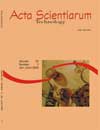<b>Fluid dynamic study of rotative pulsed fluidized bed</b> - DOI: 10.4025/actascitechnol.v26i1.1553
DOI:
https://doi.org/10.4025/actascitechnol.v26i1.1553Keywords:
fluidodinâmica, leito fluidizado, material coesivo, pulsofluidizaçãoAbstract
Cohesive particulate materials, even those that belong to the Geldart A group, present some difficulties to fluidize in conventional equipment. The rotated pulsed fluidized bed (RPFB) can be used to pulse the gas flow through the distributor plate to minimize difficulties. In this work, the used gas is at T ambient and the parameters used during the fluid dynamics studies were: C solids and F disk rotation. The fluid dynamic curve was analyzed with the variation of these parameters, and the best condition for the pulse fluidization of the bed was determined. The fluid dynamic curve obtained for the RPFB was compared with the conventional fluid dynamic bed curve. A smoothness of the curve for the RPFB was observed, and as a consequence, a decrease of the APbed during the process. A comparison between the RPFB and the mechanically agitated fluidized bed (Ambrosio, 1999) was also done and it was verified that the pressure drop in both systems are very close during the processDownloads
Download data is not yet available.
Downloads
Published
2008-03-31
How to Cite
Ambrósio-Ugri, M. C. B., & Taranto, O. P. (2008). <b>Fluid dynamic study of rotative pulsed fluidized bed</b> - DOI: 10.4025/actascitechnol.v26i1.1553. Acta Scientiarum. Technology, 26(1), 53–57. https://doi.org/10.4025/actascitechnol.v26i1.1553
Issue
Section
Chemical Engineering
License
DECLARATION OF ORIGINALITY AND COPYRIGHTS
I Declare that current article is original and has not been submitted for publication, in part or in whole, to any other national or international journal.
The copyrights belong exclusively to the authors. Published content is licensed under Creative Commons Attribution 4.0 (CC BY 4.0) guidelines, which allows sharing (copy and distribution of the material in any medium or format) and adaptation (remix, transform, and build upon the material) for any purpose, even commercially, under the terms of attribution.
Read this link for further information on how to use CC BY 4.0 properly.











8.png)




